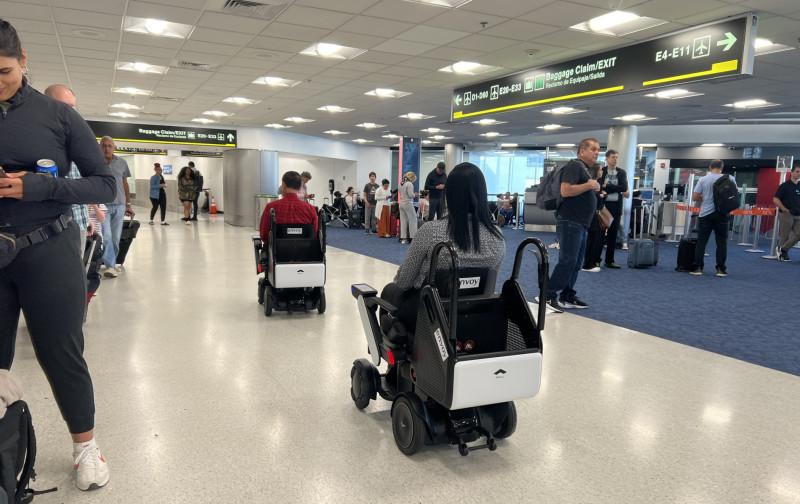Airports See ‘Big Role’ For Autonomous Technology In Terminal, Ground Services

Autonomous wheelchairs are already being tested in some airports.
GRAND RAPIDS, Michigan—While much of the discussion around autonomous operations in aviation centers on the potential implications for the future of flight, airports are actively exploring autonomy for a wide range of functions, from snow removal on airfields to wheelchair services in terminals.
“We can see in the future autonomy playing a big role at airports, whether it's platooning snow plows or mowing the grass in the airfield,” Grand Rapids Gerald R. Ford International Airport (GRR) CEO Tory Richardson said Sept. 8 here at the Airports Council International-North America (ACI-NA) conference and exhibition.
“We would rather have, say, one maintenance technician out there supervising maybe five autonomous vehicles [to mow lawns or remove snow], as opposed to five people having to sit out there and operate those five vehicles, for example, using mowing equipment for 12 hr. a day," he added.
GRR, the second-largest airport in Michigan after Detroit Metro (DTW), has established the Ford Launchpad for Innovative Technologies and Entrepreneurship (FLITE) program, which provides grants that allow for real-time testing of new technologies in an airport environment.
Autonomous airfield lawn mowers have been tested at GRR as part of the program, for example, with the FAA looking at the results with an eye toward safety implications of having such vehicles moving near taxiways and runways. The FLITE program has also tested products provided by Snowbotix, which builds electric robots designed for functions such as snow removal and sidewalk cleaning.
Southwest Airlines is a partner in the FLITE program, providing guidance on what technologies to test and assessing implications on airport operations. “Testing new products and solutions is very expensive and requires a lot of resources and time and development to bring these things to our employees and our customers,” said Kevin Kleist, Southwest’s senior emerging trends advisor. “FLITE gives us a chance to test, to try to learn and gather insights. We don't always have the resources, so it helps us take advantage of the program to do that testing. You know, innovation is difficult.
“It's hard to always find the right startups and the right companies to bring in, and I think that by having the opportunity for them to come into this program, it gives us a chance to understand scale in an airport environment, because scale is really important for Southwest. When the startup comes in, they may have an amazing product, they say you can solve a million different problems, but if you can't scale,” it is not useful to a large airline, he said.
Autonomous wheelchairs
Autonomous wheelchairs in airport terminals are seen as a near-term solution close to implementation, at least on a limited basis. Envoy Air, the American Airlines regional affiliate, is already using 10 autonomous wheelchairs each at Miami International and Los Angeles International airports to move passengers through terminals.
Prospect Airport Services, which operates wheelchair services under contract at GRR and other airports, has used the FLITE program to test various autonomous wheelchair technologies in airport operations at GRR. The company hopes to begin deploying autonomous wheelchairs at GRR, DTW and potentially other airports by the fourth quarter of this year.
Speaking at the ACI-NA conference on the importance of the FLITE program for testing the autonomous wheelchairs, Prospect Airport Services Director Tim Fisher explained: “We wanted to have real passengers in them to get some feedback, anything from the ergonomics of the chair itself, to how it moves, how it accelerates, those kinds of things. You want that real-world experience, because there's a lot of information you can't get in the lab.”
Wheelchair services at airports have remained the same for decades, he said. “It's a person behind a chair pushing it—a pretty manual process and very time intensive.”
Autonomous wheelchairs would allow airport workers to focus on passengers who need significant help, he explained. “Some people really need our assistance for a long period of time,” Fisher said. “Maybe it's somebody who's quadriplegic or paraplegic, where they need assistance through the whole airport environment. Whereas you might have somebody else that just can't walk that mile down to the gate. The autonomous chair can take them to their gate. What that does is it frees up our employees to help the passengers that really legitimately need that attention and care throughout their journey in the airport.”
He noted that the FLITE program allowed for testing passenger reactions to autonomous wheelchairs in real time as GRR conducted normal operations. “It was really funny because if the chair was empty and driving itself around, people would step back,” Fisher explained. “If there was a passenger in the chair, people were a little more accepting … We looked at the speed of these chairs, which can probably go up to 6 or 7 mph. You'd never want to go that fast in an airport environment. We learned that really quick. But also, if you dialed it back to a mile and a half an hour, everybody got upset it was going too slow. It was a lot of trial and error.”
GRR handled 3.8 million passengers in 2023—its most ever and up 6% over 2019—which had been the previous record year for passenger numbers. The airport has flight connections to around 30 domestic points in the U.S.





